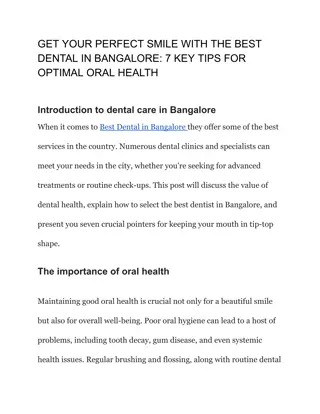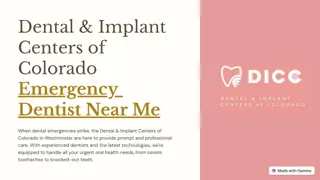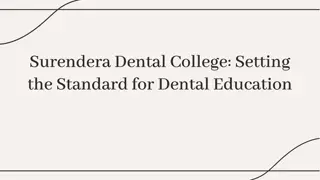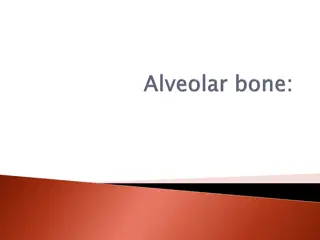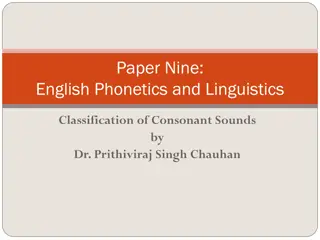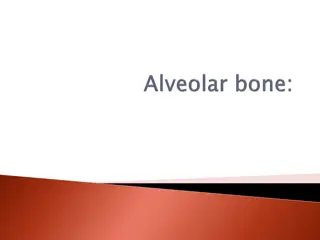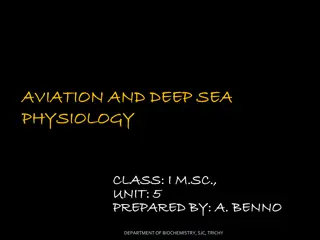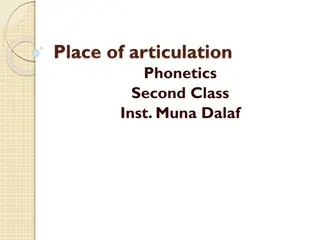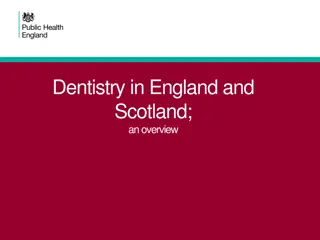Understanding the Role of Alveolar Process in Dental Support
The alveolar process in the upper and lower jaw plays a crucial role in supporting teeth, anchoring them to the alveoli with Sharpey's fibers. It helps in tooth movement for proper occlusion, absorbs and distributes occlusal forces, supplies vessels to the periodontal ligament, and protects both primary and permanent teeth. During dental development, tooth germs form within bony structures, with bony septa and bridges separating individual tooth germs. Bone remodeling occurs to facilitate tooth eruption, and the alveolar process evolves with root development. Differentiation of cells in the dental follicle into osteoblasts contributes to the formation of alveolar bone. The alveolar process diminishes in height post-teeth loss.
Download Presentation

Please find below an Image/Link to download the presentation.
The content on the website is provided AS IS for your information and personal use only. It may not be sold, licensed, or shared on other websites without obtaining consent from the author. Download presentation by click this link. If you encounter any issues during the download, it is possible that the publisher has removed the file from their server.
E N D
Presentation Transcript
Is that part of upper/lower jaw that responsible for carrying the teeth and support them. In addition to provide the attachment of some muscles of the face and mastication.
1- Houses the roots of teeth:Anchors the roots of teeth to the alveoli, which is achieved by the insertion of Sharpey s fibers into the alveolar bone proper 2-Helps to move the teeth for better occlusion. 3-Helps to absorb and distribute occlusal forces generated during tooth contact. 4-Supplies vessels to periodontal ligament. 5- Houses and protects developing permanent teeth, while supporting primary teeth. 6-Organizes eruption of primary and permanent teeth.
Near the end of the second month of fetal life, the maxilla as well as the mandible form a groove that is open towards the surface of the oral cavity. Tooth germs develop within the bony structures at late bell stage. Bony septa and bony bridge begin to form and separate the individual tooth germs from one another, keeping individual tooth germs in clearly outlined bony compartments.
Tooth germ movement occurs by bone remodeling of bony compartment through bone resorption and bone deposition. The major changes in the alveolar process begin to occur with development of roots and tooth eruption. As roots develop, the alveolar process increases in height. Also, the cells in the dental follicle start to differentiate into periodontal ligament and cementum.
At the same time, some cells in the dental follicle differentiate into osteoblasts and form alveolar bone proper. Hence, an alveolar process develops only during the eruption of the teeth. It is important to realize that, during growth, part of the alveolar process is gradually incorporated into the maxillary or mandibular body while it grows at a fairly rapid rate at its free borders. The alveolar process gradually diminishes in height after the loss of teeth.
Two parts of the alveolar process can be distinguished, the alveolar bone proper and the supporting alveolar bone. a a- -Alveolar bone proper The alveolar bone proper consists partly of lamellated and partly of bundle bone. It surrounds the root of the tooth and gives attachment to principal fibers of the periodontal ligament. Alveolar bone proper
The lamellar bone contains osteons each of which has a blood vessel in a haversian canal. Blood vessel is surrounded by concentric lamellae to form osteon. Some lamellae of the lamellated bone are arranged roughly parallel to the surface of the adjacent marrow spaces, whereas others form haversian systems.
Bundle bone is that bone in which the principal fibers of the periodontal ligament are anchored. The term bundle was chosen, because, the bundles of the principal fibers continue into the bone as Sharpey s fibers. The bundle bone is characterized by the scarcity of the fibrils in the intercellular substance. These fibrils, more over, are all arranged at right angles to Sharpey s fibers. Bundle bone is formed in areas of recent bone apposition.
Radiographically, it is also referred to as the lamina dura, because, of increased radiopacity, which is due to the presence of thick bone without trabeculations, that X-rays must penetrate and not to any increased mineral content. The alveolar bone proper, which forms the inner wall of the socket is perforated by many openings that carry branches of the interalveolar nerves and blood vessels into the periodontal ligament, and it is therefore called the cribriform plate cribriform plate .
Bone between the teeth is called interdental septum cribriform plate. The interdental and interradicular septa contain the perforating canals of Zuckerkandl and Hirschfeld (nutrient canals) which house the interdental and interradicular arteries, veins, lymph vessels and nerves. interdental septum and is composed entirely of
(a) Cortical plates (b) Spongy bone a a- -Cortical plates Cortical plates consist of compact bone and form the outer and inner plates of the alveolar processes. The cortical plates, continuous with the compact layers of the maxillary and mandibular body, are generally much thinner in the maxilla, than in the mandible. They are thickest in the premolar and molar region of the lower jaw, especially on the buccal side. In the maxilla, the outer cortical plate is perforated by many small openings through which blood and lymph vessels pass. In the region of the anterior teeth of both jaws, the supporting bone usually is very thin. Cortical plates
No spongy bone is found here, and the cortical plate is fused with the alveolar bone proper. Both cribriform plate and cortical plate are compact bone separated by spongy bone. Histologically, the cortical plates consist of longitudinal lamellae and haversian systems .In the lower jaw, circumferential or basic lamellae reach from the body of the mandible into the cortical plates.
Spongy bone fills the area between the cortical plates and the alveolar bone proper. It contains trabeculae of lamellar bone. These are surrounded by marrow that is rich in adipocytes and pluripotent mesenchymal cells. The trabeculae contain osteocytes in the interior and osteoblasts or osteoclasts on the surface. These trabeculae of the spongy bone buttress the functional forces to which alveolar bone proper is exposed. The cancellous component in maxilla is more than in the mandible.
Type I the interdental and interradicular trabeculae are regular and horizontal in a ladder like arrangement. The architecture of type I is seen most often in the mandible and fits well into the general idea of a trajectory pattern of spongy bone. Type II shows irregularly arranged, numerous, delicate interdental and interradicular trabeculae. Type II, although evidently functionally satisfactory, lacks a distinct trajectory pattern, which seems to be compensated for
by the greater number of trabeculae in any given area. This arrangement is more common in the maxilla. Both types show a variation in thickness of trabeculae and size of marrow spaces.
Mesial drift and continuous tooth eruption elicit remodeling of alveolar bone proper. During the mesial drift of a tooth, bone is apposed on the distal and resorbed on the mesial alveolar wall .The distal wall is made up almost entirely of bundle bone. However, the osteoclasts in the adjacent marrow spaces remove part of the bundle bone, when it reaches a certain thickness.
In its place, lamellated bone is deposited. On the mesial alveolar wall of a drifting tooth, the sign of active resorption is the presence of Howship s lacunae containing osteoclasts. Bundle bone, however, on this side is always present in some areas but forms merely a thin layer. This is because the mesial drift of a tooth does not occur simply as a bodily movement. Thus resorption does not involve the entire mesial surface of the alveolus at one and the same time
Moreover, periods of resorption alternate with periods of rest and repair. It is during these periods of repair that bundle bone is formed, and detached periodontal fibers are again secured. Islands of bundle bone are separated from the lamellated bone by reversal lines that turn their convexities towards the lamellated bone.
During these changes, compact bone may be replaced by spongy bone or spongy bone may change into compact bone. This type of internal reconstruction of bone can be observed in physiologic mesial drift or in orthodontic mesial or distal movement of teeth. In these movements an interdental septum shows apposition on one surface and resorption on the other. The result is a reconstructive shift of the interdental septum. Alterations in the structure of the alveolar bone are of great importance in connection with the physiologic eruptive movements of the teeth.
These movements are directed mesioocclusally. At the alveolar fundus the continual apposition of bone can be recognized by resting lines separating parallel layers of bundle bone. When the bundle bone has reached a certain thickness, it is resorbed partly from the marrow spaces and then replaced by lamellated bone or spongy trabeculae.
In older individuals: Alveolar sockets appear jagged and uneven. The marrow spaces have fatty infiltration. The alveolar process in edentulous jaws decreases in size. Loss of maxillary bone is accompanied by increase in size of the maxillary sinus. Internal trabecular arrangement is more open, which indicates bone loss. The distance between the crest of the alveolar bone and CEJ increases with age approximately by 2.81 mm.
Bone, although one of the hardest tissues of the human body, is biologically a highly plastic tissue. Where bone is covered by a vascularized connective tissue, it is exceedingly sensitive to pressure, whereas tension acts generally as a stimulus to the production of new bone. It is this biologic plasticity that enables the orthodontist to move teeth without disrupting their relations to the alveolar bone. Bone is resorbed on the side of pressure and apposed on the side of tension; thus the entire alveolus is allowed to shift with the tooth.
At sites of alveolar bone compression, osteoclasts proliferate and initial resorption of the superficial bone takes place. It is believed that, the initial response may involve osteoblasts which can produce collagenolytic enzymes to remove a portion of unmineralized extracellular matrix, thereby, facilitating access of osteoclast precursors to the bone surface.
Osteoblastic cells also produce cytokines and chemokines, which can attract monocyte precursors and promote osteoclast differentiation.retraction or apoptotic death of bone lining cells will expose the mineralized bone surface to osteoclasts. At sites of tension, osteoblasts are activated to produce osteoid that subsequently mineralizes to form new bone.
The adaptation of bone to function is quantitative as well as qualitative. Whereas, increase in functional forces leads to formation of new bone, decreased function leads to a decrease in the volume of bone. This can be observed in the supporting bone of teeth that have lost their antagonists. Here the spongy bone around the alveolus shows pronounced rarefaction
The bone trabeculae are less numerous and very thin. The alveolar bone proper, however, is generally well preserved because it continues to receive some stimuli from the tension of the periodontal tissues. During healing of fractures or extraction wounds, an embryonic type of bone is formed, which only later is replaced by mature bone.
The embryonic bone also called immature or coarse other aspects, by the greater number, size and irregular arrangement of the osteocytes than are found in mature bone. The greater number of cells and the reduced volume of calcified intercellular substance render this immature bone more radiolucent than mature bone. immature or coarse fibrillar fibrillar bone bone, is characterized, among
This explains why bony callus in radiographs at a time when histologic examination of a fracture reveals a well- developed union between the fragments and why a socket after an extraction wound appears to be empty at a time, when it is almost filled with immature bone. The visibility in radiographs lags 2 or 3 weeks behind actual formation of new bone. bony callus cannot be seen
The most frequent and harmful change in the alveolar process is that which is associated with periodontal disease. The bone resorption is almost universal, occurs more frequently in posterior teeth, is usually symmetrical, occurs in episodic spurts, is both of the horizontal and vertical type (i.e., occurs from the gingival and tooth side, respectively), and is intimately related to bacterial plaque and pocket formation. It has been shown, for example, endotoxins produced by the gram- negative bacteria of the plaque lead to an increase in cAMP, which increases the osteoclastic activity.
Resorption after tooth loss has been shown to follow a predictable pattern. The labial aspect of the alveolar crest is the principal site of resorption, which reduces first in width and later in height. The pattern of resorption is different in the maxilla and mandible. The residual alveolar ridge resorbs downward and outward in the mandible, whereas, in the maxilla the resorption is upwards and inwards. Nontraumatic loss of anterior maxillary teeth is followed by a progressive loss of bone mainly from the labial side.
In the deciduous dentition, loss of a retained second deciduous molar, which has no succedaneous permanent tooth to replace it, is also associated with bone loss. The cause for resorption of alveolar bone after tooth loss has been assumed to be due to disuse atrophy, decreased blood supply, localized inflammation or unfavorable prosthesis pressure.
Alveolar ridge defects and deformities can also be the result of congenital defects, trauma, periodontal disease or surgical ablation, as in the case of tumor surgery. Lamina dura is an important diagnostic landmark in deter- mining health of the periapical tissues. Loss of density usually means infections, inflammation and resorption of bone socket.
Traditional treatment methods for promoting bone healing primarily utilize bone grafts or synthetic materials to fill the defects and provide structural support. Bone grafting to stimulate bone deposition has been used in periodontal surgery. It involves a surgical procedure to place bone or bone substitute material into a bone defect with the objective of producing new bone and possibly the regeneration of periodontal ligament and cementum.
1-Autografts utilize the patients bone, which can be obtained from intraoral or extraoral sites. They are the best materials for bone grafting, are very well accepted by the body and may produce the fastest rate of bone growth . With autografts, the patient is assured of protection from disease transmission and/or immune reaction.
The allografts are freeze-dried at ultra-low temperatures and dried under high vacuum. They are available either demineralized or non-demineralized. allografts include growth factors which are also osteo- inductive. and induce bone growth and provide an environment that increases the body s regenerative process.
3-Xenografts are obtained from animal sources; usually cows and/or pigs. They include processed animal bone or growth proteins. Again, the risk of disease transmission and/or rejection is reduced by processing.
In cases where bone grafts from human or animal sources are not feasible a synthetic are used materials include natural and synthetic hydroxyapatites, ceramics, calcium carbonate (natural coral), silicon-containing glasses, and synthetic polymers. Synthetic materials carry no risk of disease transmission or immune system rejection. They help create an environment that facilitates the body s regenerative process.









